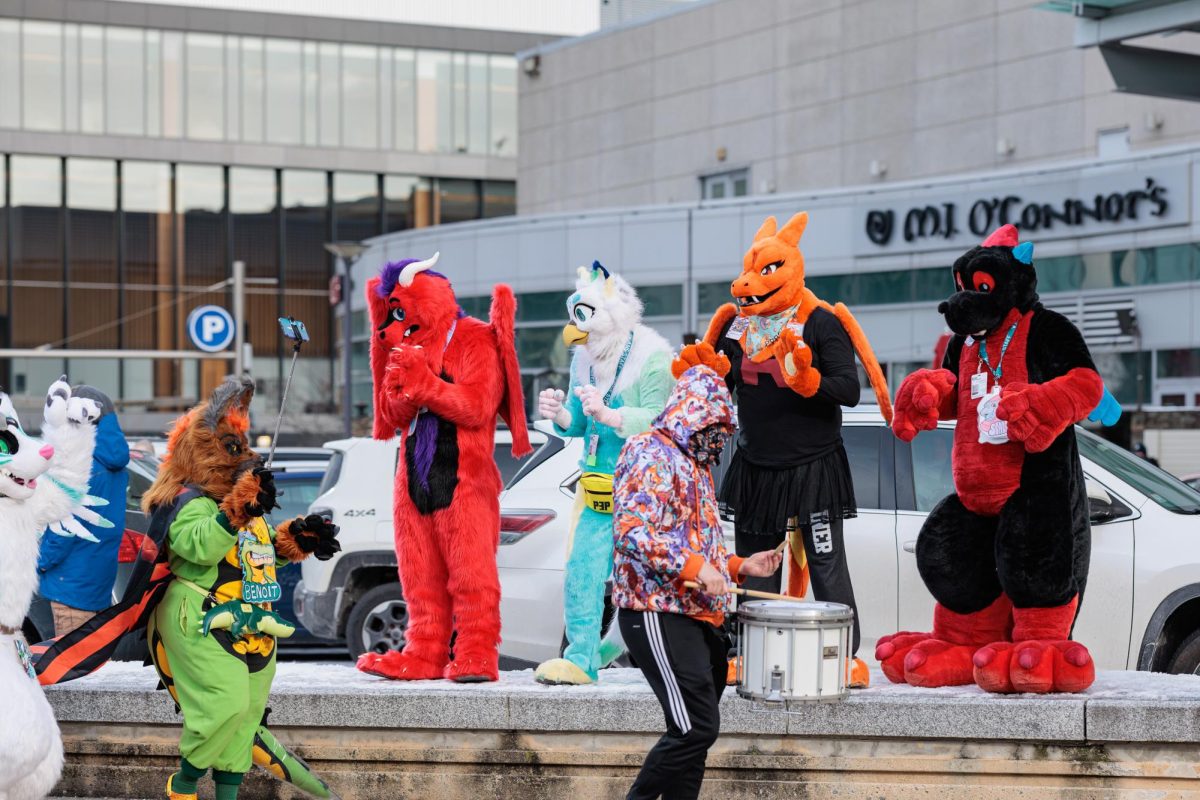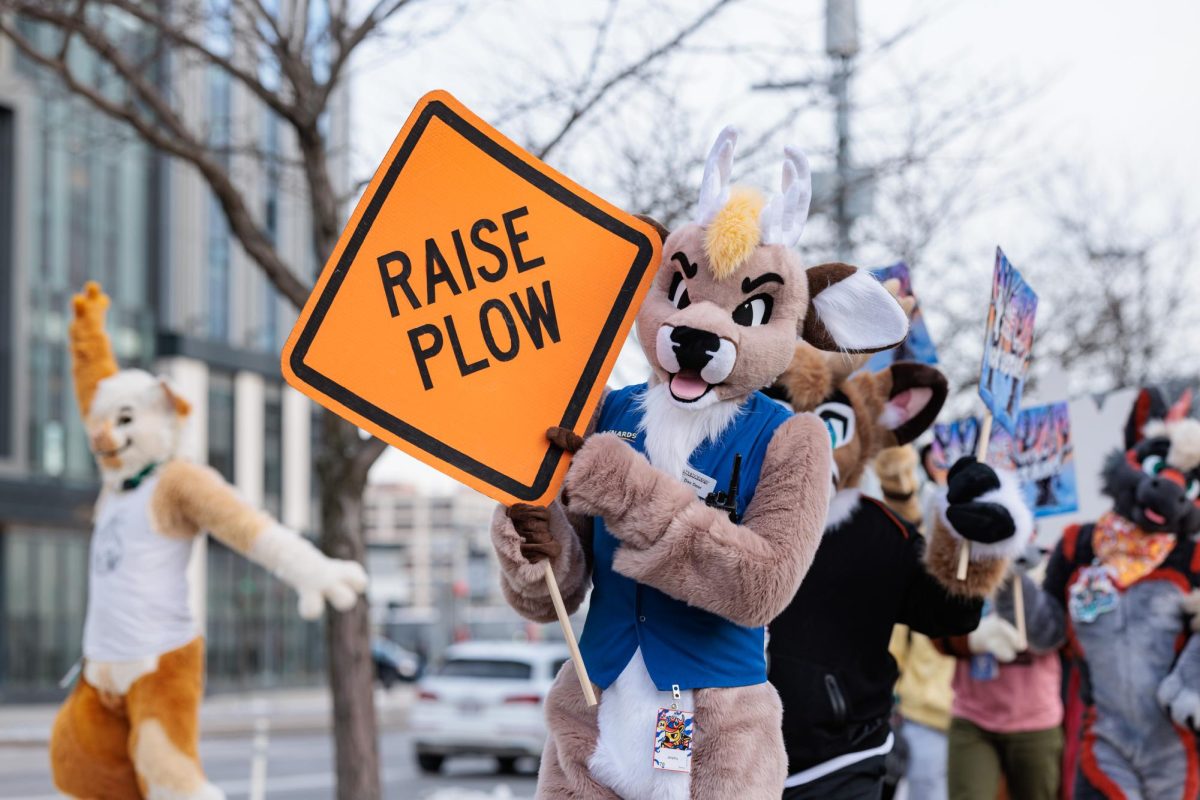Thousands of furries and members of the furry fandom converged on The Westin in Boston’s Seaport district last weekend for the eighth annual Anthro New England (ANE) furry convention. The four-day event ran from Jan. 18 through Jan. 21 and saw over 3,500 worldwide attendees dress up, pursue colorful vendor markets, and play games together to celebrate their collective interests.
The furry fandom is a subculture with a common interest in cartoon animals that display human characteristics. Some members of the fandom show this interest by dressing up in fursuits.
Even on Sunday, as the convention came to a close, The Westin lobby was a polychromatic collage of anthropomorphized anime and video game character costumes and homemade fursuits representing various attendees’ “fursonas,” or furry personas. Only about 20 percent of furries own fursuits, which was reflected at ANE, where most people wore normal clothes.

The hotel’s basement was a large, mask-required vendor space with dozens of booths encompassing just about every interest in the fandom, with everything from comics to wall art to costume parts for sale.
ANE was founded in 2014 and hosted its first convention in Cambridge in 2015. Since then, the convention has only grown in popularity and size, reflecting the increased popularity of the fandom and similar rises in convention attendance. 2024 was ANE’s second year at The Westin.
“30 years ago, a big furry con had about 500 attendees. Now, a big furry con has 20–30,000 attendees,” said Michael Lutrario, a longtime furry and ANE 2024 vendor.
Lutrario is a furry comic book collector and retailer who has been part of the fandom since the 1980s and has attended over 60 conventions.
“The fandom has grown exponentially, not just within the United States, but across the world,” Lutrario said.
According to Lutrario, furry art might have gotten a table at larger Comic Cons in the 1990s, but it was largely an underground zine movement. The internet, he said, has made the fandom much more accessible. Likewise, his business, which now ships worldwide, boomed alongside it.
Lutrario added that when he started collecting furry comics, there was a higher demand for general-audience art than adult-only comics. Since then, the demand for adult content gradually increased to become the majority before recently evening out to about a 50-50 split in demand between adult and general interests.
This inclination toward adult content was reflected in the convention, with a quarter of the vendor floor being hidden from prying eyes behind a gray curtain and specialized in selling 18+ art, toys, and posters.
Julius Caeser is a vendor from Shreveport, Louisiana, and editor of “Chasing Tail” magazine, a soft-core pornography pin-up publication that features men and women in sexual positions with animal masks and costumes on.
Caeser’s publication represents expanding various niche interests within the furry community. He has watched from the frontlines as many niche markets have gained popularity at furry conventions over the last year.
“A lot of the photography in this fandom is very modern and digital. It’s very just textureless and soulless,” Caesar said. “I wanted to bring some more natural-looking film photography into the fandom and to introduce people to the sort of style that’s kind of faded from the public consciousness.”
Caesar noted that the freedom to try new things and seeing members of the fandom gravitate to new aesthetics are his favorite aspects of the fandom itself.
“There are no gigantic furry corporations. There’s no centralized body of what exactly a furry is,” Caesar said. “It’s all just solely up to the community to decide what’s popular at any given moment.”
Matt Kaufman, a Connecticut native and vendor, also noted the importance of independence and creative freedom within the furry fandom. He brought his own dog-inspired fursuit with him to the convention.
“Honestly, [my favorite part of the fandom] just seeing how weird people can get with it,” Kaufman said. “A lot of boundary-pushing, more avant-garde aspects of art [are explored here that aren’t in the mainstream].”
Lutrario observed that the popularity and the diversity of expression, specifically in adult content, has increased in the community in recent years and has become more reflective of its core demographics. This change is especially true in catering more toward LGBTQ+ interests, as in 2021, IARP data found that 70 percent of furries identify as part of the LGBTQ+ community.
“In the beginning, [adult content] was all designed and focused on a straight audience, [but] because the furry audience has changed more and more toward LGBTQ+, so has the adult material,” Lutrario said.
Artists like Caeser introduce their preferred aesthetics to the community with the hope that it will become popular. Many other artists, however, are doing the inverse and reacting to market trends by giving community members more of what they want. As Lutrario observed, this has increasingly included sexual material.

One of the artists in the 18+ section was Beleoci, a commission artist based out of Portland, Oregon, who said they don’t inherently create explicit content but have it as an option for customers to choose from while purchasing a commission piece. Most of the drawings at their ANE booth featured anthropomorphic characters drawn in sexually suggestive ways.
“We create furry art, of course, but everyone has their own genre within that. [Mine is] like sharp, scary ladies,” Beleoci said.
Beleoci creates a wide range of commissions, from simple colored and painted illustrations to reference sheets (for single characters) and Telegram stickers.
Alexander Gouise, an event organizer and Boston local involved in registration and volunteer coordination for ANE, said the variety of interests in the community promotes inclusivity. He noted that his favorite part of the furry community is the tradition of costumed dances that help foster this safe space.
“You can have the most introverted individual, but [when] they’re on a stage, they’re in suit, they’re so lit up, they’re having a great time,” Gouise said. “It just gives anyone from a variety of different backgrounds a great kind of comfortable space to be themselves.”
The IARP estimates that between five to 15 percent of the fandom is affected by autism spectrum disorder, and 12 to 17 percent of the community identify as transgender.
James Fox, a vendor at the convention, shared how the furry community helped him explore his identity.
“I’m a trans man, and the community was what helped me support it,” said Fox, who runs Elvenhound Illustrations, a group that sells furry-inspired art based in Macungie, Pennsylvania. “Wearing a fursuit and being able to change who I was and not be judged for it was what really gave me the confidence to actually transition in the end.”
ANE is also a registered 501c7 non-profit that raises money for charities of their choosing through attendee donations. ANE 2023 raised over $20,000 for various charitable organizations listed on their website. As a non-profit organization, ANE relies on volunteers in addition to its limited staff.
This year’s sponsored charities were Youth On Fire (YOF) and Wings of the Dawn. YOF is a Cambridge-based drop-in center for homeless and street-involved youth from ages 14–24 and provides them with supplies and resources to meet basic needs.
Wings of the Dawn is a volunteer-based wildlife rehabilitation center and bird sanctuary in Henniker, New Hampshire. The organization is run by Maria Colby, who was at the event taking care of a massive red-tailed hawk with whom attendees could interact.
Gouise said the philanthropic efforts of ANE have helped its events become more meaningful.
“It’s really great to see that we can support other nonprofits that our community is connected to,” Gouise said.
This reflects what Gouise sees the convention as: a positive space filled with individuals who care deeply for one another and their community.
“I’ve never met someone who’s rude [at a convention] and everyone’s so nice and welcoming,” Gouise said. “We’re all just here to have a good time.”